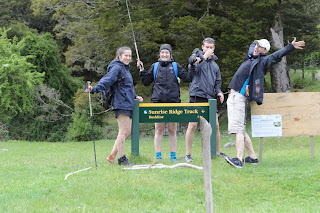I was again privileged to watch another surgery this week! A reverse shoulder replacement. They swap the ball and socket joint around so the glenoid of the scapular has the ball, and the humerus head becomes the socket. It was a similar experience to the last week; the surgeon stopped to show me specific things (like a torn rotator cuff that happened to be present).
There was a symposium happening throughout the week; there were both staff and members of the pubic present. On Tuesday I attended a session on pelvic floor training for incontinence and prolapse led by our physiotherapist. For a sensitive topic, it was a lighthearted session with strong recommendations. Can you lift your pelvic floor 12 times? That was the challenge given to the audience after we went around teaching pelvic floor activation and transversus abdominalis activation. The second part of the presentation was about 'emergency deification situation training'... almost. More like, how to improve toileting with posture optimisation. As you would expect from a physio, demonstrations were shown and the audience encouraged to practice the techniques themselves (postures only!)
Thursday I attended a presentation 'dicky tickers' on reading basic ECG strips. The nurse educator had five of us stand at the front of the group in a line. We were each given a name tag: 'SA node, AV node, bundle of his, bundle branches, and perkinje fibres'. Recognise the order? Of course you do, its the order of conductivity in the heart and subsequent order of p-waves, P-Q interval, QRS complex, T-wave. Here's what we were instructed to do: The first person (SA node) lobbed a ball into the air to the second person (AV node), this is the p-wave. The second person would then hold the ball briefly (P-Q interval) then bounce the ball high into the air passed the bundle of his and bundle branches so the last person (perkinje fibres) would receive it - the bounce represents the QRS-complex. The third and fourth people in the line (bundle of his and bundle branches) would perform a Mexican wave to show the wave of conductivity toward the perkinje fibres. Once the last person had the ball, they would run it back to the beginning of the line. This visual demonstration was useful for describing defects in the conductivity pathway as well.
Thursday I attended a presentation 'dicky tickers' on reading basic ECG strips. The nurse educator had five of us stand at the front of the group in a line. We were each given a name tag: 'SA node, AV node, bundle of his, bundle branches, and perkinje fibres'. Recognise the order? Of course you do, its the order of conductivity in the heart and subsequent order of p-waves, P-Q interval, QRS complex, T-wave. Here's what we were instructed to do: The first person (SA node) lobbed a ball into the air to the second person (AV node), this is the p-wave. The second person would then hold the ball briefly (P-Q interval) then bounce the ball high into the air passed the bundle of his and bundle branches so the last person (perkinje fibres) would receive it - the bounce represents the QRS-complex. The third and fourth people in the line (bundle of his and bundle branches) would perform a Mexican wave to show the wave of conductivity toward the perkinje fibres. Once the last person had the ball, they would run it back to the beginning of the line. This visual demonstration was useful for describing defects in the conductivity pathway as well.
On Friday the symposium offered presentations from orthopaedic surgeons on topics including: compartment syndrome, multi-trauma patients, femoral fractures and dealing with angry patients/family.
On Wednesday the physio (and ?Occupational Therapy) staff came together to celebrate the last week of placement for the year by sharing a lunch. I brought brownies but didn't actually attend the shared lunch as I was observing the shoulder replacement surgery. I talked to another student physio later in the afternoon who reported that it was a success, having given gifts to our clinical educator, Michael M. and to the physio department in thanks for all their support and patience during the year.
There is a planned end of year celebration at each of the placement centres (CHCH, Dunedin, Wellington) and some of the satellite sites, like Nelson. The plan is to share a few drinks and nibbles between ourselves on Friday.
To conclude the year, we hand in our hospital ID cards and as per usual there is a portfolio to submit for the placement. Typically, students will be gearing up for graduation, registration and job hunting by now. I'll be returning to complete papers next year, so I'll resume this blog then - I'm undecided about whether I'll continue weekly updates, or block-updates. Congratulations to my fellow peers who graduate in December and go on to be great physiotherapists!
I'll finish with a page from the Physio Matters magazine - I was lucky to be asked for a second second entry. This one sums up the year pretty well (minus a few hick-ups / speed bumps along the way).



